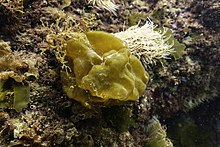
Lough Foyle, sometimes Loch Foyle, is the estuary of the River Foyle, on the north coast of Ireland. It lies between County Londonderry in Northern Ireland and County Donegal in the Republic of Ireland. Sovereignty over the waters has been in dispute since the Partition of Ireland.

Palmaria palmata, also called dulse, dillisk or dilsk, red dulse, sea lettuce flakes, or creathnach, is a red alga (Rhodophyta) previously referred to as Rhodymenia palmata. It grows on the northern coasts of the Atlantic and Pacific Oceans. It is a well-known snack food. In Iceland, where it is known as söl[ˈsœːl̥], it has been an important source of dietary fiber throughout the centuries.
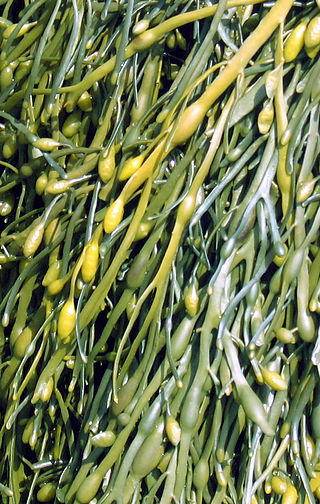
Ascophyllum nodosum is a large, common cold water seaweed or brown alga (Phaeophyceae) in the family Fucaceae, being the only species in the genus Ascophyllum. It is a seaweed that grows only in the northern Atlantic Ocean, also known in localities as feamainn bhuí, rockweed, Norwegian kelp, knotted kelp, knotted wrack or egg wrack. It is common on the north-western coast of Europe including east Greenland and the north-eastern coast of North America, its range further south of these latitudes being limited by warmer ocean waters.

Fucus serratus is a seaweed of the north Atlantic Ocean, known as toothed wrack, serrated wrack, or saw rack.

William Henry Harvey, FRS FLS was an Irish botanist and phycologist who specialised in algae.

Atractophora hypnoides is a rare red alga (Rhodophyta) found in the British Isles, France and some Atlantic Islands and is the only species of the genus found in the British Isles. It is attached to the rock or other algae by a small basal disc and is much branched with downgrowing filaments which enclose the main branch or axis forming a cortex. Short filaments of limited growth radiate in whorls from the axis and frequently convert into hairs. The spreading filaments grow irregularly in a diffuse manner. Microscope examination is required for identification.
The history of phycology is the history of the scientific study of algae. Human interest in plants as food goes back into the origins of the species, and knowledge of algae can be traced back more than two thousand years. However, only in the last three hundred years has that knowledge evolved into a rapidly developing science.

Colpomenia is a genus of brown macroalgae in the family Scytosiphonaceae.

Gastroclonium reflexum is a small red alga (Rhodophyta) reported from Ireland and Britain.

Sargassum muticum, commonly known as Japanese wireweed or japweed, is a large brown seaweed of the genus Sargassum. It is an invasive seaweed with high growth rate. It has an efficient dispersion thanks to its floats.

Fucus distichus or rockweed is a species of brown alga in the family Fucaceae to be found in the intertidal zones of rocky seashores in the Northern Hemisphere, mostly in rock pools.

Colpomenia sinuosa, commonly named the oyster thief or sinuous ballweed, is a brown algae species in the genus Colpomenia. It is the type species of its genus and is widespread in tropical to temperate zones around the world.

Cystoseira foeniculacea is a species of brown alga in the genus Cystoseira.
Mary Johnston(e) Lynn was an Irish botanist known for her phyto-ecological studies in Northern Ireland.
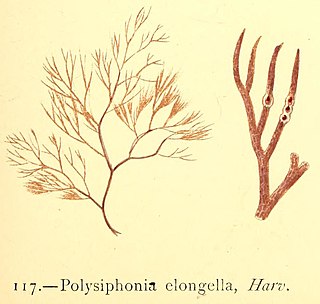
Polysiphonia elongella Harvey in W.J. Hooker is a branched species of marine red algae in the genus in the Polysiphonia in the Rhodophyta.

Ceramium echionotum is a small marine alga in the division Rhodophyta.
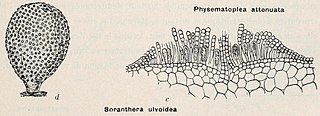
Soranthera ulvoidea, sometimes called the studded sea balloon, is a species of brown algae in the family Chordariaceae. It is the only species in the monotypic genus Soranthera. The generic name Soranthera is from the Greek soros (heap) and antheros (blooming). The specific epithet ulvoidea refers to certain resemblances the algae has with Ulva. The name in Japanese is 千島袋のり / ちしまふろくのり literally meaning "Kuril Islands bag nori".

Codium bursa is a green marine algae of medium size.
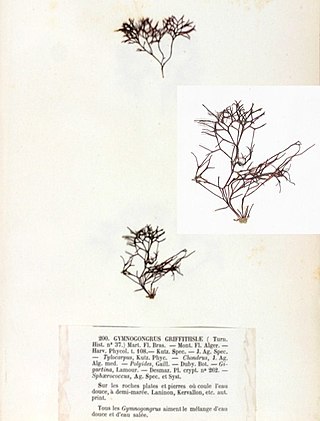
Gymnogongrus griffithsiae is a small uncommon seaweed.
Margaret Constance Helen Blackler (1902–1981) was a British phycologist, botanical collector and museum curator.
